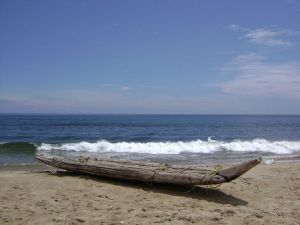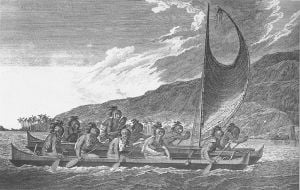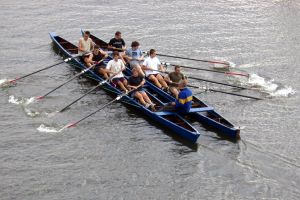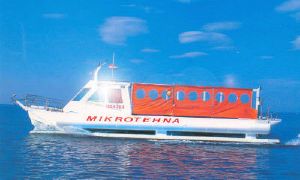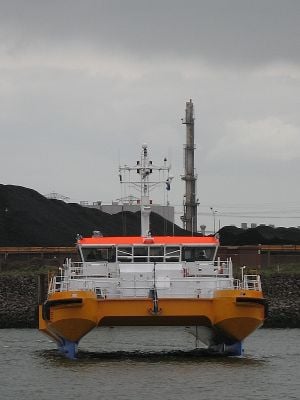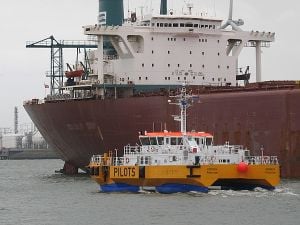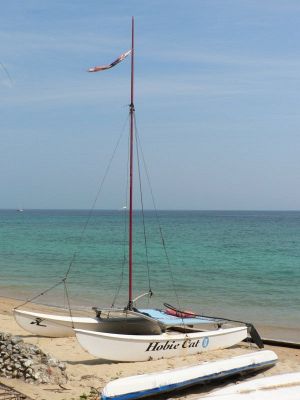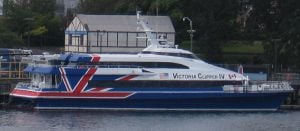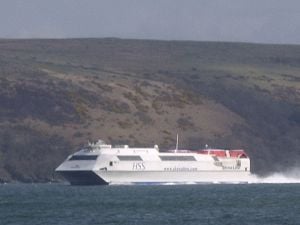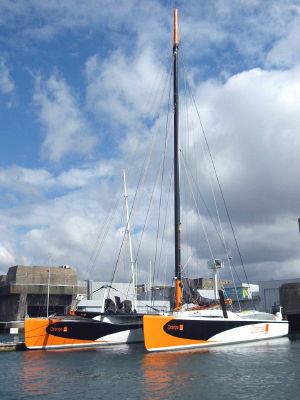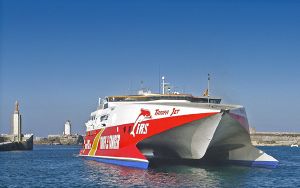Catamaran
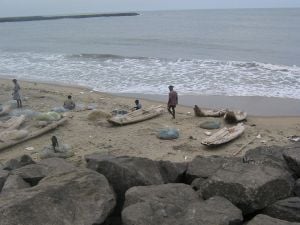
A catamaran (from Tamil kattumaram)[1] is a type of multihulled boat or ship consisting of two hulls, or Vakas, joined by a frame, formed of Akas. Catamarans can be sail- or engine-powered. The catamaran was first discovered being used by the paravas, a fishing community in the southern coast of Tamil Nadu, India. Catamarans were used by the ancient Tamil Chola dynasty as early as the fifth century C.E. to move their fleets to invade such Southeast Asian regions as Burma, Indonesia, and Malaysia.
Catamarans are a relatively recent introduction to the design of boats for both leisure and sport sailing, although they have been used for millennia in Oceania, where Polynesian catamarans and outrigger canoes allowed seafaring Polynesians to settle the world's most far-flung islands.
In recreational sailing, catamarans and multihulls, in general, have been met by a degree of skepticism from Western sailors accustomed to more "traditional" monohull designs.[2] The main source of that skepticism was that multihulls were based on concepts that were completely alien and strange to them, with balance based on geometry rather than weight distribution. The second source of that skepticism is that catamarans work better than traditional designs, and with less weight, therefore ridiculing the traditional concepts. In the realm of fast ferries, where their powering characteristics and spacious arrangements are of value, the catamaran has become arguably the hull form of first choice.
Multihull component terms
There are three terms that describe the components of modern multihulls (catamarans and trimarans): vaka, aka, and ama.[3] The term vaka, like the related terms aka and ama, come from the Malay and Micronesian language group terms for parts of the outrigger canoe, and vaka can be roughly translated as canoe or main hull.[4]
- Aka[4] - The aka of a multihull sailboat is a member of the framework that connects the hull to the ama(s) (outrigger). The term aka originated with the proa, but is also applied to modern trimarans.
- Ama[4] - The term ama comes from the proa. The vaka is the main hull, the ama is the outrigger, and the aka[4] or iako (Hawaiian) is the support connecting the two (not three) hulls. The term ama and aka have been widely applied to modern trimarans.
- Vaka[4] - A proa consists of a vaka, the main canoe-like hull; an ama, the outrigger; and akas, the poles connecting the ama to the vaka.
Semantically, the catamaran is a pair of Vaka held together by Aka, whereas the trimaran is a central Vaka, with Ama on each side, attached by Aka.
History
The English adventurer and buccaneer William Dampier, traveling around the world in the 1690s in search of business opportunities, once found himself on the southeastern coast of India, in Tamil Nadu. He was the first to write in English about a kind of vessel he observed there. It was little more than a raft made of logs.
‚ÄĚOn the coast of Coromandel," he wrote in 1697, "they call them Catamarans. These are but one Log, or two, sometimes of a sort of light Wood ... so small, that they carry but one Man, whose legs and breech are always in the Water.‚ÄĚ
While the name came from Tamil, the modern catamaran came from the South Pacific. English visitors applied the Tamil name catamaran to the swift, stable sail and paddle boats made out of two widely separated logs and used by Polynesian natives to get from one island to another.
The design remained relatively unknown in the West for almost another 200 years, until an American, Nathanael Herreshoff, began to build catamaran boats of his own design in 1877 (US Pat. No. 189,459), namely 'Amaryllis', which immediately showed her superior performance capabilities, at her maiden regatta (The Centennial Regatta held on June 22, 1876, off the New York Yacht Club's Staten Island station[2]). It was this same event, after being protested by the losers, where Catamarans, as a design, were barred from all the regular classes[2] and they remained barred until the 1970s.
This ban relegated the catamaran to being a mere novelty boat design until 1947.[5] In 1947, surfing legend, Woodbridge "Woody" Brown and Alfred Kumalae designed and built the first modern ocean-going catamaran, Manu Kai, in Hawaii. Their young assistant was Rudy Choy, who later founded the design firm Choy/Seaman/Kumalae (C/S/K, 1957) and became a fountainhead for the catamaran movement. The Prout Brothers, Roland and Francis, experimented with catamarans in 1949 and converted their 1935 boat factory in Canvey Island, Essex (England) to catamaran production in 1954. Their Shearwater catamarans won races easily against the single hulled yachts.
The speed and stability of these catamarans soon made them a popular pleasure craft, with their popularity really taking off in Europe, and was followed soon thereafter in America. Currently, most individually owned catamarans are built in France, South Africa, and Australia.
In the mid-twentieth century, the catamaran inspired an even more popular sailboat, the Beach Cat. In California, a maker of surfboards, Hobie Alter produced (in 1967) the 250-pound Hobie Cat 14, and two years later the larger and even more successful Hobie 16. That boat remains in production, with more than 100,000 made in the past three decades.
The Tornado catamaran is an Olympic class sailing catamaran, with a crew of two. It has been in the Olympic Games since 1976. It was designed in 1967 by Rodney March of Brightlingsea, England, with help from Terry Pierce, and Reg White, specifically for the purpose of becoming the Olympic catamaran. At the IYRU Olympic Catamaran Trials, it easily defeated the other challengers.
Variations
The normal catamaran multihull, powered or not, consists of two Amas separated by two Akas, which may suspend a platform or trampoline between them. They can be of various sizes and recently, they have become very large.
Pontoon Boat or Hydroairy Ship
The hydroairy ship appears to be nothing more than an upgraded and enlarged pontoon boat with a formed and shaped underplatform. The general architecture is identical, consisting of two flotation chambers, for the Amas, joined by a load carrying platform, which carries the superstructure.
In 1952, Minnesota farmer Ambrose Weeres had an idea that if you put a wooden deck on top of two columns of steel barrels welded together end to end, you would have a sturdy deck that would be more stable on a lake than a conventional boat.[6] Weeres was walking the same idea paths as the early Polynesians, while proving that the ideas behind the multihull are not all that counterintuitive.
These sorts of boats are cheap and easy to make, require no ballast, and thus have good performance. Although, this design is almost exclusively restricted to power boats. It is still, essentially, a catamaran. No displacement is lost towards ballast, therefore yielding huge operational efficiencies.
SWATH
The Small Waterplane Area Twin Hull (SWATH) is a hull form used for vessels that require a ship of a certain size to handle in rough seas as well as a much larger vessel. An added benefit is a high proportion of deck area for their displacement‚ÄĒin other words, large without being heavy. The SWATH form was invented by Canadian Frederick G. Creed, who presented his idea in 1938 and was later awarded a British patent for it in 1946. It was first used in the 1960s and 1970s as an evolution of catamaran design for use as oceanographic research vessels or submarine rescue ships.
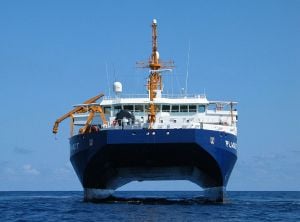
Catamarans provide large, broad decks, but have much higher water resistance than monohulls of comparable size. To reduce some of that resistance (the part that generates waves), as much displacement volume as possible is moved to the lower hull and the waterline cross-section is narrowed sharply, creating the distinctive pair of bulbous hulls below the waterline and the narrow struts supporting the upper hull. This design means that the ship's flotation runs mostly under the waves, like a submarine (the smooth ride of a sub was the inspiration for the design). The result is that a fairly small ship can run very steady in rough seas. A 50-meter ship can operate at near full power in nearly any direction in waves as high as 12 meters
The S.W.A.T.H. theory was further developed by Dr Thomas G. Lang, inventor of improvements to the semi-submerged ship (S3) in about 1968. Basically, a SWATH vessel consists of two parallel torpedo like hulls attached to which are two or more streamlined struts which pierce the water surface and support an above water platform. The US Navy commissioned the construction of a SWATH ship called the 'Kaimalino' to prove the theory as part of their ship research program. The Kaimalino has been operating successfully in the rough seas off the Hawaiian islands since 1975.
Usage and Application
Sailing Beach Catamarans
Although the principles of sailing are the same for both catamarans and monohulls, there are some "peculiarities‚ÄĚ to sailing catamarans. For example:
- Catamarans can be harder to tack if they don't have dagger boards or centre boards. All sailboats must resist lateral movement in order to sail in directions other than downwind and they do this by either the hull itself or else dagger boards or centre boards. Also, because catamarans are lighter in proportion to their sail size, they have less momentum to carry them through the turn when they are head to wind. Correct use of the jib sail (back-filling the jib to pull the bow around) is often essential in successfully completing a tack without ending up stuck in irons (pointing dead into the wind and sailing backwards, see: No-Go Zone).
- They have a higher speed than other sailboats of the same size. This is because they can have a much larger sail area due to the larger righting moment. They can reach over 1.5 times the speed of the wind.
- Catamarans are less likely to capsize in the classic 'beam-wise' manner but often have a tendency to pitchpole instead‚ÄĒwhere the leeward (downwind) bow sinks into the water and the boat 'trips' over forward, leading to a capsize.
Teaching for new sailors is usually carried out in monohulls as they are thought easier to learn to sail, a mixture of all the differences mentioned probably contributes to this.
Catamarans, and multihulls in general, are normally faster than single-hull boats for three reasons:
- catamarans are lighter due to the fact there is no keel counterweight;
- catamarans have a wider beam (the distance from one side of the boat to the other), which makes them more stable and therefore able to carry more sail area per unit of length than an equivalent monohull; and
- the greater stability means that the sail is more likely to stay upright in a gust, drawing more power than a monohull's sail which is more likely to heel (lean) over.
A catamaran is most likely to achieve its maximum speed when its forward motion is not unduly disturbed by wave action. This is achieved in waters where the wavelength of the waves is somewhat greater than the waterline length of the hulls, or it is achieved by the design piercing the waves. In either case pitching (rocking horse-like motion) is reduced. This has led to it being said that catamarans are especially favorable in coastal waters, where the often sheltered waters permit the boat to reach and maintain its maximum speed.
Catamarans make good cruising and long distance boats: The Race (around the world, in 2001) was won by the giant catamaran Club Med skippered by Grant Dalton. It went round the earth in 62 days at an average speed of eighteen knots.
Catamarans for passenger transport
An increasing trend is the deployment of a catamaran as a high speed ferry. The use of catamaran for high speed passenger transport was pioneered by Westermoen Hydrofoil in Mandal, Norway, who launched the Westamaran design in 1973. The Westamarans, and later design, some of them consisting of a catamaran hull resting on an air cushion between the hulls, became dominant for all high speed connections along the Norwegian coast. They could achieve speeds comparable to the hydrofoils that it replaced, and was much more tolerant to foul water and wave conditions.
Powered catamarans
A recent development in catamaran design has been the introduction of the power catamaran. The 'power' version incorporates the best features of a motor yacht and combines it with the characteristics of a multihull.
Usually, the power catamaran is devoid of any sailing apparatus as demonstrated by one of the top-selling models in the United States, the Lagoon Power 43. This vessel has now been introduced to a number of charter fleets in the Caribbean and the Mediterranean and is becoming an increasingly common sight.
Smaller powered catamarans are becoming quite common in the United States with several manufacturers producing quality boats. A small "cat" will almost certainly have two engines while a similar sized mono-hull would only one engine. All mid-size and larger cats will have two engines.
Cruising Sail Cats
Below a minimum size, about eight meters (24 ft.), the catamaran's hulls do not have enough volume to allow them to be used as living space. At the same time, the bridgedeck area isn't sufficiently sized to make effective live-aboard space either. This limits their use to beachcats and day sailors. However, once one gets above that, both the bridgedeck area and the hulls gain sufficient size for use as compartments and navigation decks. These are the cruising catamarans that are being seen more often at yacht clubs that host circumnavigators.
While more popular in the EU, they are gaining popularity in the US as well due to their superior comfort, stability, safety, and speed, over monohulls. These boats can maintain a comfortable 300 nmpd (nautical miles per day) passage, with the racing versions recording well over 400 nmpd, and they do this while being unsinkable. This is extremely desirable, for circumnavigating the world. In addition, they don't heel more than 10-12 degrees, even at full speed on a reach.
Even without the actual need to circumnavigate, these catamaran megayachts allow a level of comfort and life-style not possible on a monohull sailboat and only previously possible on large power cruisers. This is their attraction.
Due to the perceived need to retain single-handed sail handling, 45 m is expected to remain the upper limit for this class of yacht.
Mega catamarans
One of the biggest developments over the last decade in the yachting arena has been the rise of the super catamaran: a multihull over 100 feet in length, in semi-custom and custom designs.
Various international manufacturers are leading the way in this area including Blubay, Yapluka, Sunreef, Lagoon and Privilege. A catamaran 150 feet in length is under construction at Derektor shipyards in Bridgeport, Connecticut.
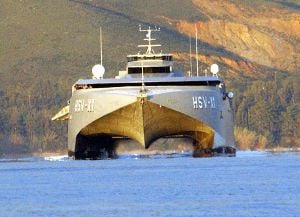
The emergence of the super or mega catamaran is a relatively new event which is akin to the rise of the mega or super yacht which was used to describe the huge growth in luxury, large motor yachts in the French Riviera and Floridian Coast.
One of the reasons for increased mega catamaran construction was The Race, a circumnavigation challenge that departed from Barcelona, Spain, on New Year's Eve, 2000. Due to the prize money and prestige associated with this event, four new catamarans (and two highly modified ones) over 100 feet in length were built to compete. The largest, "PlayStation", owned by Steve Fossett, was 125 feet long and had a mast which was 147 feet above the water. Virtually all of the new mega cats were built of pre-preg carbon fiber for strength and the lowest possible weight. Top speeds of these boats can approach 50 knots.
See also
| |||||
Notes
- ‚ÜĎ Catamaran Online Etymology Dictionary. Retrieved June 17, 2008.
- ‚ÜĎ 2.0 2.1 2.2 L. Francis Herreshoff, The Spirit of the Times, November 24, 1877 (reprint). Marine Publishing Co., Camden, ME. Retrieved June 17, 2008.
- ‚ÜĎ The Tridarka Raider Tridarkaraider. Retrieved June 17, 2008.
- ‚ÜĎ 4.0 4.1 4.2 4.3 4.4 A primer on proas Proafile. Retrieved June 17, 2008.
- ‚ÜĎ The UCI later created this same sort of ban, in 1934, when it invalidated Faure's record of 45 km in one hour, in July 7, 1933, on a Recumbent bicycle, with rule changes specifically designed to exclude the Recumbent bicycle, where Recumbent bicycle technology was similarly repressed.
- ‚ÜĎ WEERES History Retrieved June 25, 2008.
ReferencesISBN links support NWE through referral fees
- Berman, Phil, and Bradford Scott. 1999. Catamaran Sailing: From Start to Finish. New York, NY: W. W. Norton & Co. ISBN 9780393318807
- Marchaj, C. A. 1980. Aero-Hydrodynamics of Sailing. New York, NY: Dodd, Mead. ISBN 9780396077398
- ‚ÄĒ‚ÄĒ‚ÄĒ. 2003. Sail Performance: Techniques to Maximize Sail Power. London, UK: Adlard Coles Nautical. ISBN 9780713664072
- ‚ÄĒ‚ÄĒ‚ÄĒ. 1986. Seaworthiness: The Forgotten Factor. Camden, ME: International Marine Pub. Co. ISBN 9780877422273
- Tarjan, Gregor. 2007. Catamarans. Camden, MI: International Marine. ISBN 0071498850
External links
All links retrieved November 30, 2023.
- Catamaran Sailing at TheBeachcats.com Site devoted to all types of small catamarans known as beachcats.
Credits
New World Encyclopedia writers and editors rewrote and completed the Wikipedia article in accordance with New World Encyclopedia standards. This article abides by terms of the Creative Commons CC-by-sa 3.0 License (CC-by-sa), which may be used and disseminated with proper attribution. Credit is due under the terms of this license that can reference both the New World Encyclopedia contributors and the selfless volunteer contributors of the Wikimedia Foundation. To cite this article click here for a list of acceptable citing formats.The history of earlier contributions by wikipedians is accessible to researchers here:
The history of this article since it was imported to New World Encyclopedia:
Note: Some restrictions may apply to use of individual images which are separately licensed.
